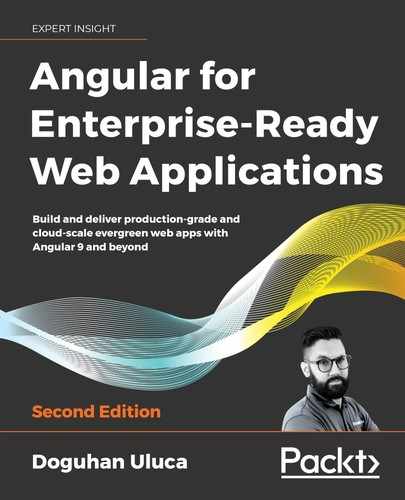Book Description
Revised and updated second edition of the bestselling hands-on guide to building enterprise-ready web apps using an evergreen Angular platform
Key Features
- Updated examples, projects, and a new overview of tools – including NgRX and Ivy, automated testing, and Firebase authentication
- New chapter summarizing history of web frameworks and Angular version updates
- All-new RESTful API implementation leveraging the MEAN stack with MongoDB, Express.js, Angular and Node.js
Book Description
This second edition of Angular for Enterprise-Ready Web Applications is updated with in-depth coverage of the evergreen Angular platform.
You'll start by mastering Angular programming fundamentals. Using the Kanban method and GitHub tools, you'll build great-looking apps with Angular Material and also leverage reactive programming patterns with RxJS, discover the flux pattern with NgRx, become familiar with automated testing, utilize continuous integration using CircleCI, and deploy your app to the cloud using Vercel Now and GCloud.
You will then learn how to design and develop line-of-business apps using router-first architecture with observable data anchors, demonstrated through oft-used recipes like master/detail views, and data tables with pagination and forms. Next, you'll discover robust authentication and authorization design demonstrated via integration with Firebase, API documentation using Swagger, and API implementation using the MEAN stack.
Finally, you will learn about DevOps using Docker, build a highly available cloud infrastructure on AWS, capture user behavior with Google Analytics, and perform load testing. By the end of the book, you'll be familiar with the entire gamut of modern web development and full-stack architecture, learning patterns and practices to be successful as an individual developer on the web or as a team in the enterprise.
What you will learn
- Adopt a minimalist, value-first approach to delivering web apps
- Master Angular development fundamentals, RxJS, CLI tools, GitHub, and Docker
- Discover the flux pattern and NgRx
- Implement a RESTful APIs using Node.js, Express.js, and MongoDB
- Create secure and efficient web apps for any cloud provider or your own servers
- Deploy your app on highly available cloud infrastructure using DevOps, CircleCI, and AWS
Who this book is for
This book is for developers who want to confidently deliver high-quality and production-grade Angular apps from design to deployment. Developers that have prior experience in writing a RESTful APIs will also benefit, as well as developers who will gain greater awareness of how they fit into the larger picture of delivering a web application. Prior experience with RESTful APIs is desired.
Table of Contents
- Preface
- Introduction to Angular and Its Concepts
- Setting Up Your Development Environment
- Creating a Basic Angular App
- Automated Testing, CI, and Release to Production
- Delivering High-Quality UX with Material
- Angular Material
- Angular Material setup and performance
- Angular Flex Layout
- Using Material components
- Accessibility
- Building an interactive prototype
- Summary
- Further reading
- Exercises
- Questions
- Forms, Observables, and Subjects
- Creating a Router-First Line-of-Business App
- The 80-20 solution
- Router-first architecture
- Creating LemonMart
- Generating router-enabled modules
- Branding, customization, and Material icons
- Feature modules with lazy loading
- Completing the walking skeleton
- Common testing module
- Designing around major data entities
- High-level UX design
- Summary
- Further reading
- Questions
- Designing Authentication and Authorization
- DevOps Using Docker
- RESTful APIs and Full-Stack Implementation
- Recipes – Reusability, Routing, and Caching
- Recipes – Master/Detail, Data Tables, and NgRx
- Highly Available Cloud Infrastructure on AWS
- Google Analytics and Advanced Cloud Ops
- Appendix A: Debugging Angular
- Appendix B: Angular Cheat Sheet
- Another Book You May Enjoy
- Index
